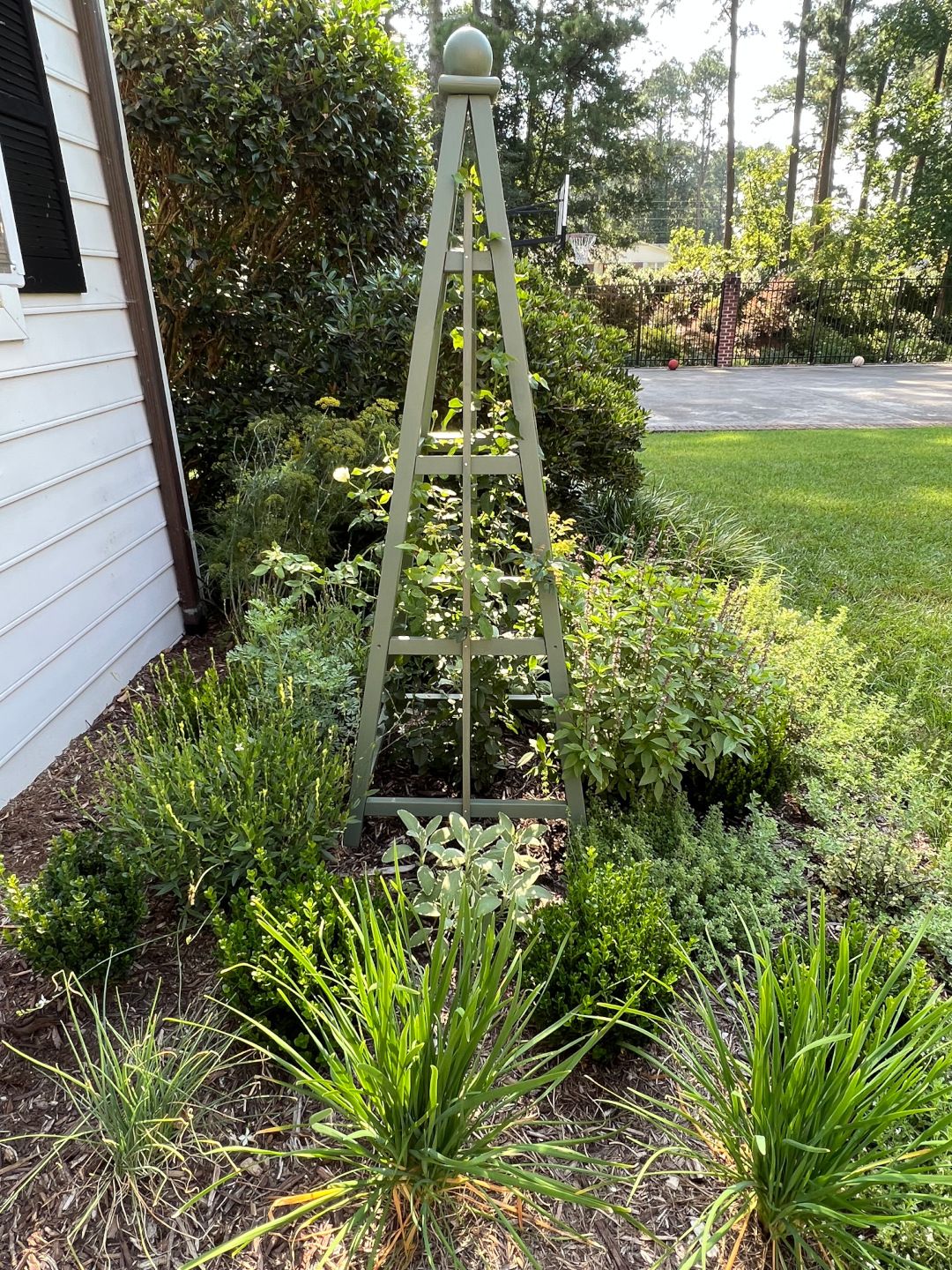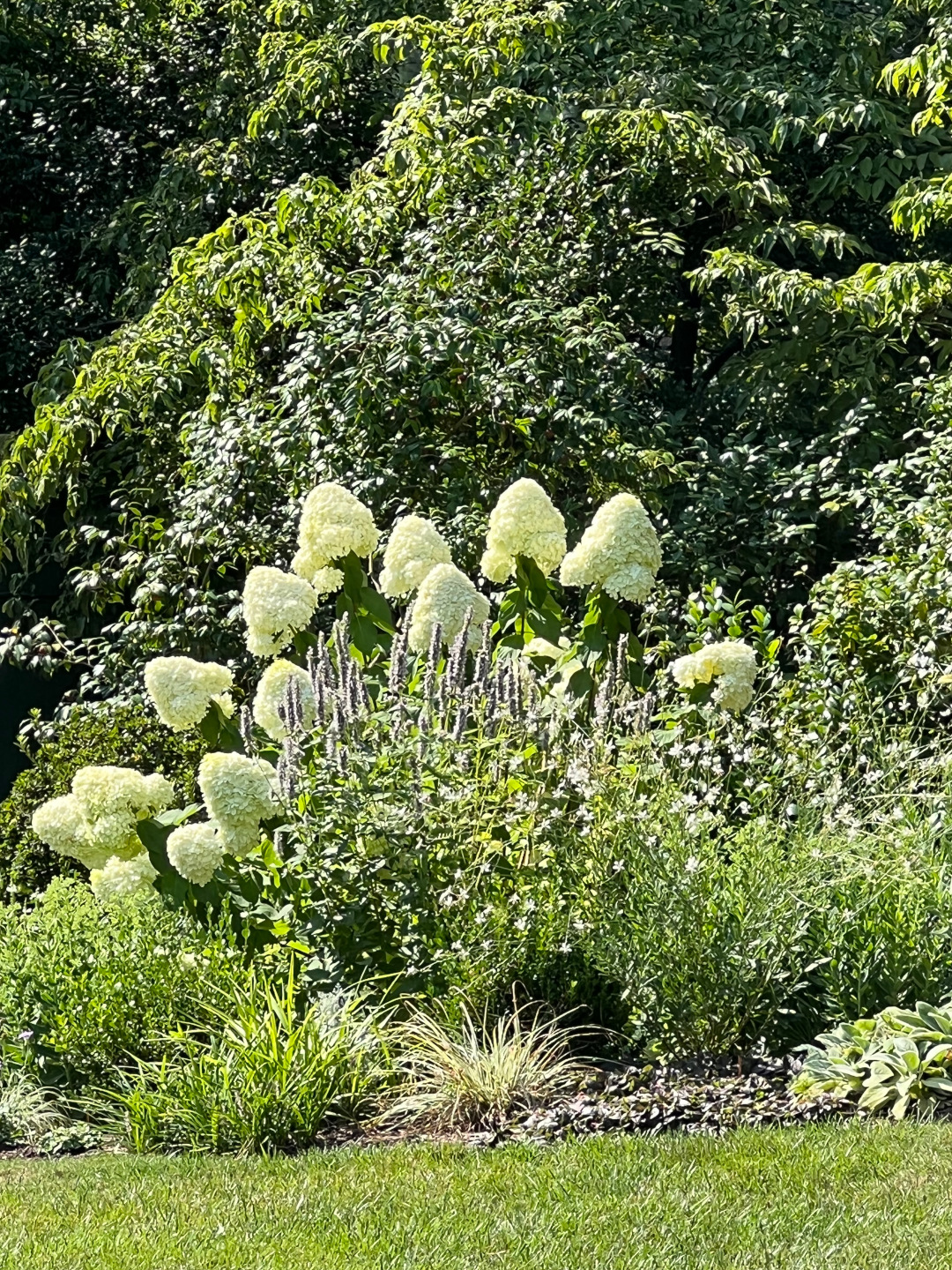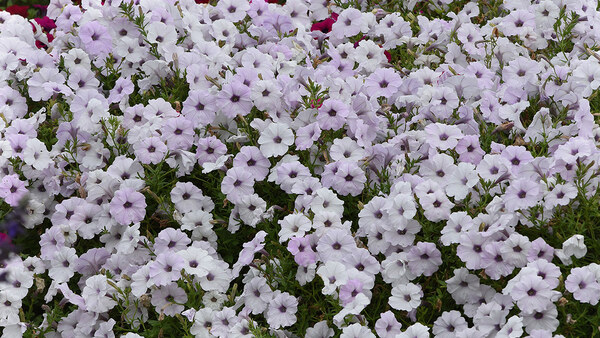
Today we’re visiting Amy Birdsong’s garden in Virginia.
Two years ago I became serious about restoring and improving our property, which up until then my husband had valiantly been taking care of with little to no input or help from me. As a kitchen and bath designer I am well versed in space planning, but I had zero knowledge on how to create a true garden. So like all good students, I went all in on research. I began visiting gardens, buying an embarrassing amount of garden books, obsessively combed the internet for information, popped into any and all nurseries within a 50-mile range, asked a ton of questions of people whose gardens I admire, and consulted a landscape designer. My quick-hits list of rules are highlighted by our July garden, which is breathtaking right now in all its summer glory.
 Pruning hydrangeas correctly is a challenge, but they are tough, so just keep trying. This border is actually five years old with a new Empress of China dogwood (Cornus elptica ‘Elsbry’, Zones 6–9). Every year I pruned the ‘Little Lime’ hydrangeas (Hydrangea paniculata ‘Little Lime’, Zones 4–8), but they would end up scraggly and floppy by midsummer. This year I utilized Fine Gardening’s pruning tutorial and finally found success.
Pruning hydrangeas correctly is a challenge, but they are tough, so just keep trying. This border is actually five years old with a new Empress of China dogwood (Cornus elptica ‘Elsbry’, Zones 6–9). Every year I pruned the ‘Little Lime’ hydrangeas (Hydrangea paniculata ‘Little Lime’, Zones 4–8), but they would end up scraggly and floppy by midsummer. This year I utilized Fine Gardening’s pruning tutorial and finally found success.
 Move plants that aren’t happy, even if it’s not recommended. This Guara ‘Whirling Butterflies’ (Zones 5–9) was thin and covered in aphids. Several online sources said you couldn’t move Gaura easily due to their long taproots, but it was so pitiful there was nothing to lose. Now on the edge of the driveway where the soil is thin, it has exploded and is self-seeding like crazy.
Move plants that aren’t happy, even if it’s not recommended. This Guara ‘Whirling Butterflies’ (Zones 5–9) was thin and covered in aphids. Several online sources said you couldn’t move Gaura easily due to their long taproots, but it was so pitiful there was nothing to lose. Now on the edge of the driveway where the soil is thin, it has exploded and is self-seeding like crazy.
 A tree stump is an opportunity for a specimen plant. We lost a pine tree here and were left with a stump at ground level. The spot needed something with height. An inexpensive cask fits the woodland vibe of the area, and this ‘Spider’s Web’ fatsia (Fatsia japonica ‘Spider’s Web’, Zones 7–10) is a wonderful pop of color all year long.
A tree stump is an opportunity for a specimen plant. We lost a pine tree here and were left with a stump at ground level. The spot needed something with height. An inexpensive cask fits the woodland vibe of the area, and this ‘Spider’s Web’ fatsia (Fatsia japonica ‘Spider’s Web’, Zones 7–10) is a wonderful pop of color all year long.
 Herb gardens can be beautiful. While herbs are messy and can be invasive, they are also often evergreen and provide lots of interesting contrasts of texture and color. A landscape designer suggested the tuteur, which elevates the space. I’ve planted a David Austin rose, which has already started blooming. Unfortunately, the Japanese beetles have found it.
Herb gardens can be beautiful. While herbs are messy and can be invasive, they are also often evergreen and provide lots of interesting contrasts of texture and color. A landscape designer suggested the tuteur, which elevates the space. I’ve planted a David Austin rose, which has already started blooming. Unfortunately, the Japanese beetles have found it.
 Closer look at the herb garden
Closer look at the herb garden
 Create little vignettes. This is a spot by our back door planted with jasmine (Jasminum officinalis, Zones 7–10), a ‘Steeds’ Japanese holly (Ilex crenata ‘Steeds’, Zones 5–8), lambs’ ears (Stachys byzantina, Zones 4–9), and snowhill salvia (Salvia nemorosa ‘Snowhill’, Zones 4–9). I’ve cut back one of the salvias and left the other to see how they compare in a few months.
Create little vignettes. This is a spot by our back door planted with jasmine (Jasminum officinalis, Zones 7–10), a ‘Steeds’ Japanese holly (Ilex crenata ‘Steeds’, Zones 5–8), lambs’ ears (Stachys byzantina, Zones 4–9), and snowhill salvia (Salvia nemorosa ‘Snowhill’, Zones 4–9). I’ve cut back one of the salvias and left the other to see how they compare in a few months.
 Variegated plants are everything, and you can mix them! For years I disliked variegated plants (which I read is common with new gardeners). I just wanted green on green on green. Last fall a friend shared a blog post that featured a flower border called the “Black and White” garden. In it the owner used all types of variegation from silver, chartreuse, white, and sage. It was magical, so I embraced the idea and am happy with the results. The key seems to be having enough deep green to offset the variegated plants, but also repetition so it doesn’t look accidental. Here a golden yellow Euphorbia ‘Ascot Rainbow’ (Zones 5–9) glows with the darker greens around it.
Variegated plants are everything, and you can mix them! For years I disliked variegated plants (which I read is common with new gardeners). I just wanted green on green on green. Last fall a friend shared a blog post that featured a flower border called the “Black and White” garden. In it the owner used all types of variegation from silver, chartreuse, white, and sage. It was magical, so I embraced the idea and am happy with the results. The key seems to be having enough deep green to offset the variegated plants, but also repetition so it doesn’t look accidental. Here a golden yellow Euphorbia ‘Ascot Rainbow’ (Zones 5–9) glows with the darker greens around it.
 Use evergreen plants to provide structure and backdrops for flowering plants. A border of all flowers can be beautiful, but it can also be messy and only fully shines during peak flowering season. In addition, like in interior design, the eye needs places to rest, and things stand out when there is a neutral backdrop. Evergreens don’t have to be shrubs; carex, lirope, ground covers such as ajuga and lambs’ ears, and sedums come in a variety of colors and textures. Like variegated plants, they can happily comingle for an English garden look.
Use evergreen plants to provide structure and backdrops for flowering plants. A border of all flowers can be beautiful, but it can also be messy and only fully shines during peak flowering season. In addition, like in interior design, the eye needs places to rest, and things stand out when there is a neutral backdrop. Evergreens don’t have to be shrubs; carex, lirope, ground covers such as ajuga and lambs’ ears, and sedums come in a variety of colors and textures. Like variegated plants, they can happily comingle for an English garden look.
 Lastly, mix heights within the border. When you look at pictures where everything is lined up like soldiers with ground covers in front and very strictly getting progressively taller, it looks unnatural. Obviously you don’t want 6-foot-tall shrubs or flowers at the very front, but a garden or border is more interesting if it reveals different views as you walk toward, beside, or even within it.
Lastly, mix heights within the border. When you look at pictures where everything is lined up like soldiers with ground covers in front and very strictly getting progressively taller, it looks unnatural. Obviously you don’t want 6-foot-tall shrubs or flowers at the very front, but a garden or border is more interesting if it reveals different views as you walk toward, beside, or even within it.
Have a garden you’d like to share?
Have photos to share? We’d love to see your garden, a particular collection of plants you love, or a wonderful garden you had the chance to visit!
To submit, send 5-10 photos to [email protected] along with some information about the plants in the pictures and where you took the photos. We’d love to hear where you are located, how long you’ve been gardening, successes you are proud of, failures you learned from, hopes for the future, favorite plants, or funny stories from your garden.
Have a mobile phone? Tag your photos on Facebook, Instagram or Twitter with #FineGardening!
Do you receive the GPOD by email yet? Sign up here.

















Comments
Lovely! You have created a wonderful garden you can enjoy year around! Great job!✨🍃✨
I think that coming from the world of interior design, Amy has learned to share strategies that gardeners can learn from. The notion of giving plants a setting in which to shine on their own, but still relate to other specimens nearby offers great wisdom. And of course the lessons of visiting gardens to inspire and improve what isn't working are key to such successses. Kudos!
Just wondering, Amy, which cultivar of panicle hydrangea is featured in a few of these photos with enormous panicles? Could you have 'Vanilla Strawberry'? Those seem to have some of the biggest flowers I see in SE Pennsylvania
Really lovely.
Amy - thank you for taking the time to share your insightful gardening story!
I love a garden with a bit of a theme to the color and this is so calming with the white flowers set against the difference shades of green foliage.
You really did find your passion for gardening with all the books you checked out and the nurseries and gardens you visited and really found a design of your own making.
And your garden turned out just fabulous- it's a beautiful creation!
I’ve often been tempted to call the gal who has helped me with interior design to give me advice on the garden. Clearly, many of the same principles will apply.
Your advice about mixing variegation was interesting; I’m often hesitant to mix gold, silver, and cream highlights. I may need to rethink that. And I rarely repeat the variegation— rethinking that, too!
Your "studies" proved to be very successful - this is a really lovely garden. Agree completely with not stacking heights from short in front to tall in back - a nice curve of different heights and widths always looks so much nicer and natural. Your Guara story has inspired me to try again - had it in northern NJ, but have had no success here in NC. Will put sand/pebbles in the next time I try to see if that combats the clay here enough to make it happy. Thanks for sharing your beautiful creation!
It’s amazing how much we can learn when we take an interest. You e done an incredible job snd thanks for your suggestions.
Log in or create an account to post a comment.
Sign up Log in